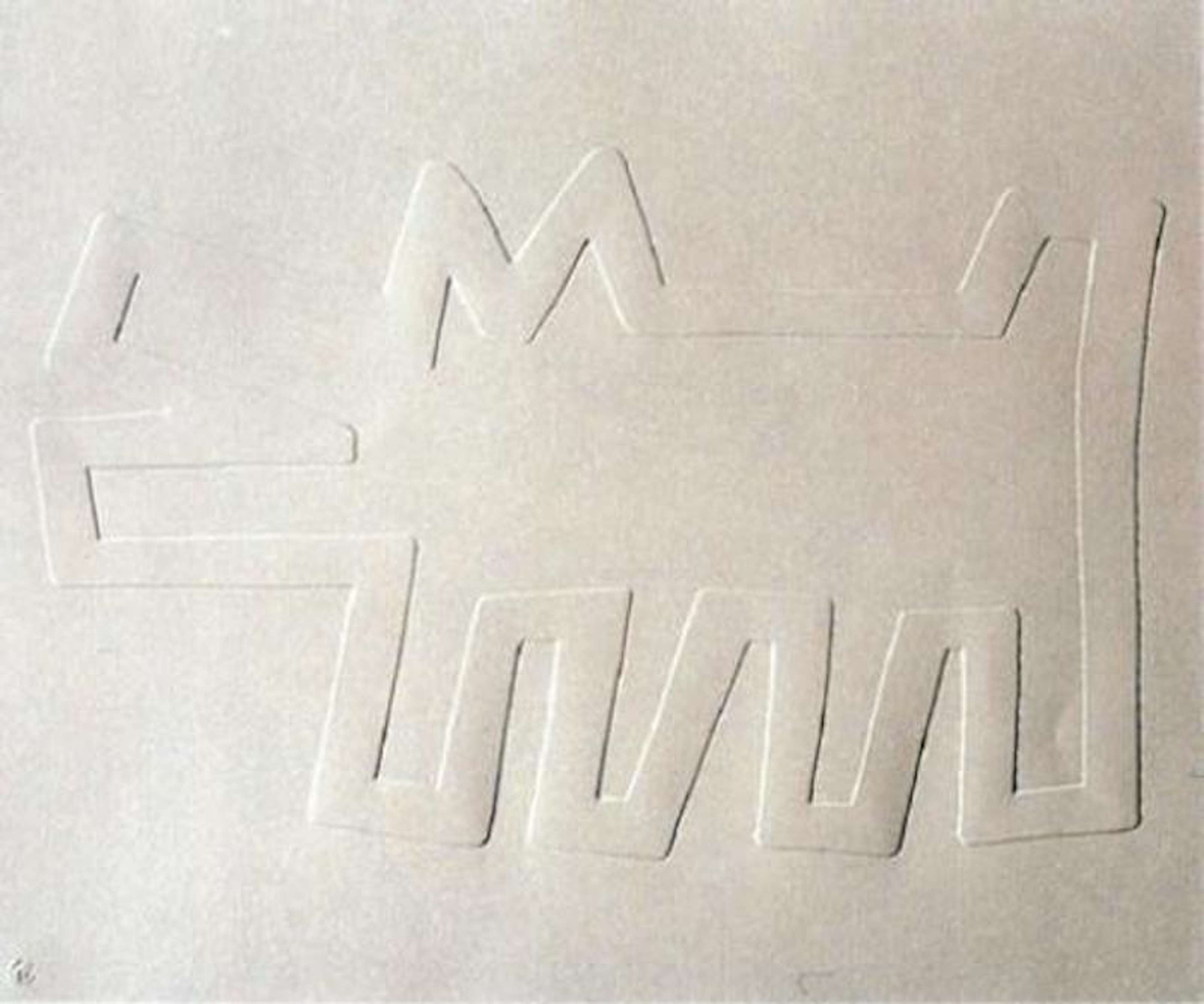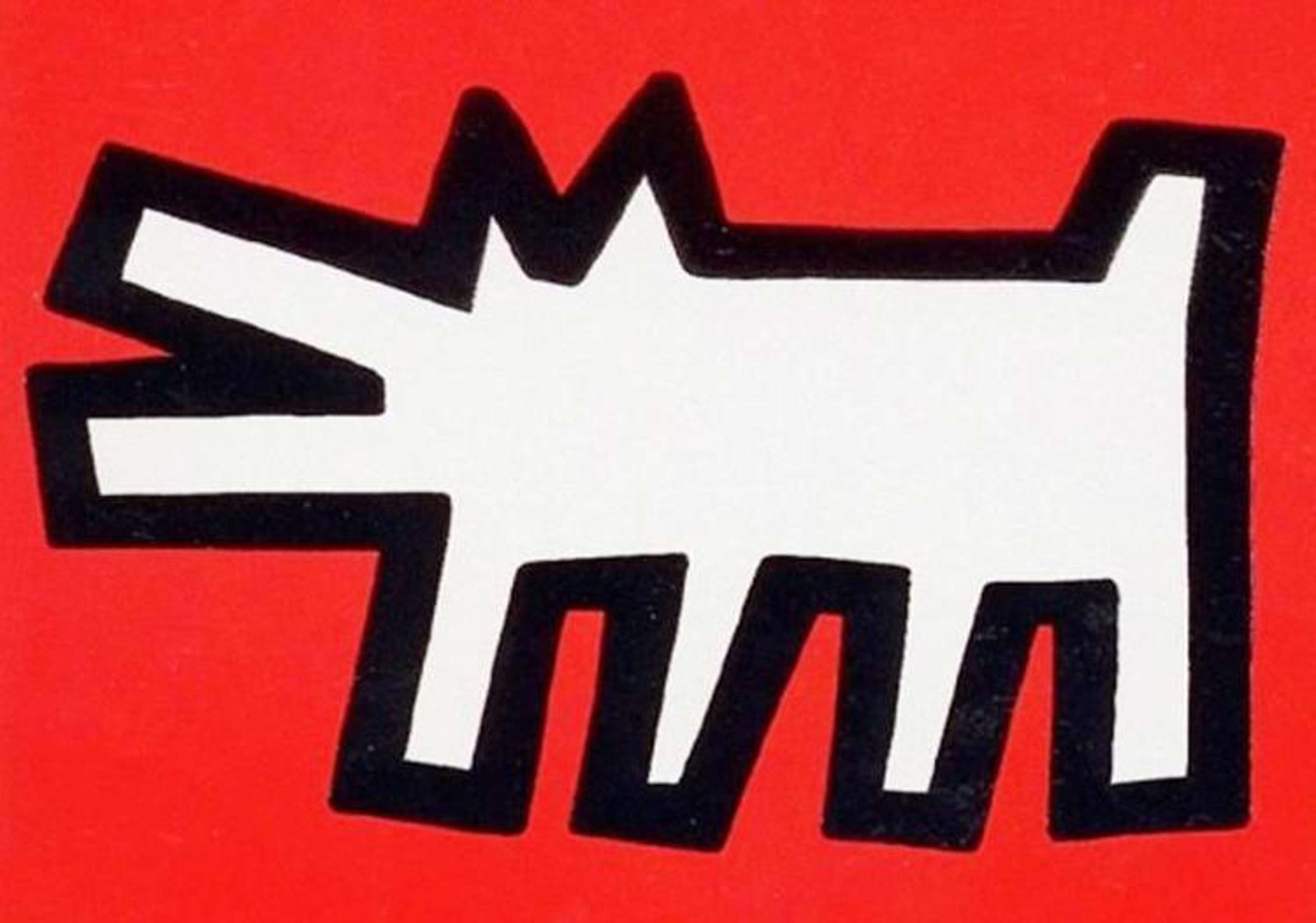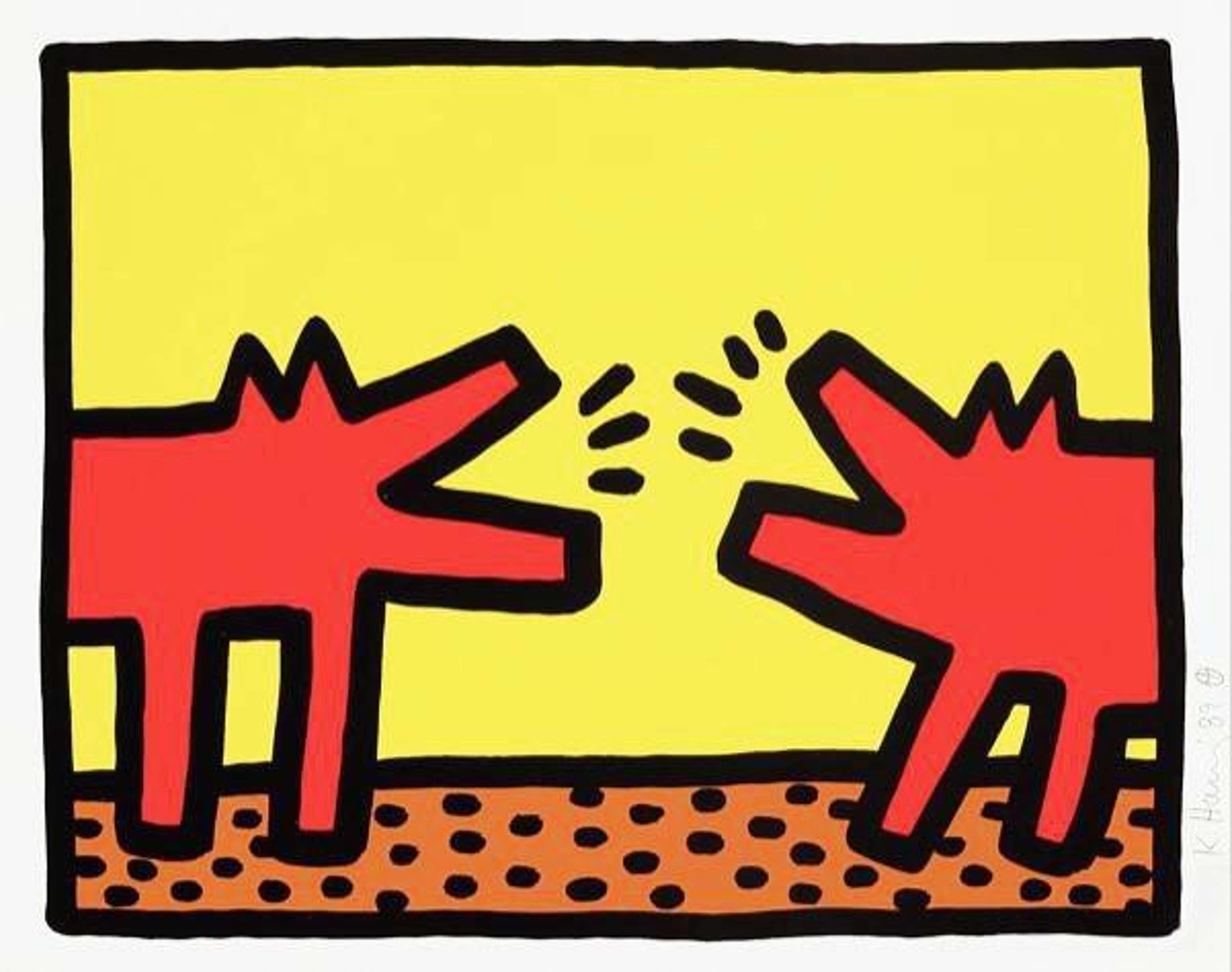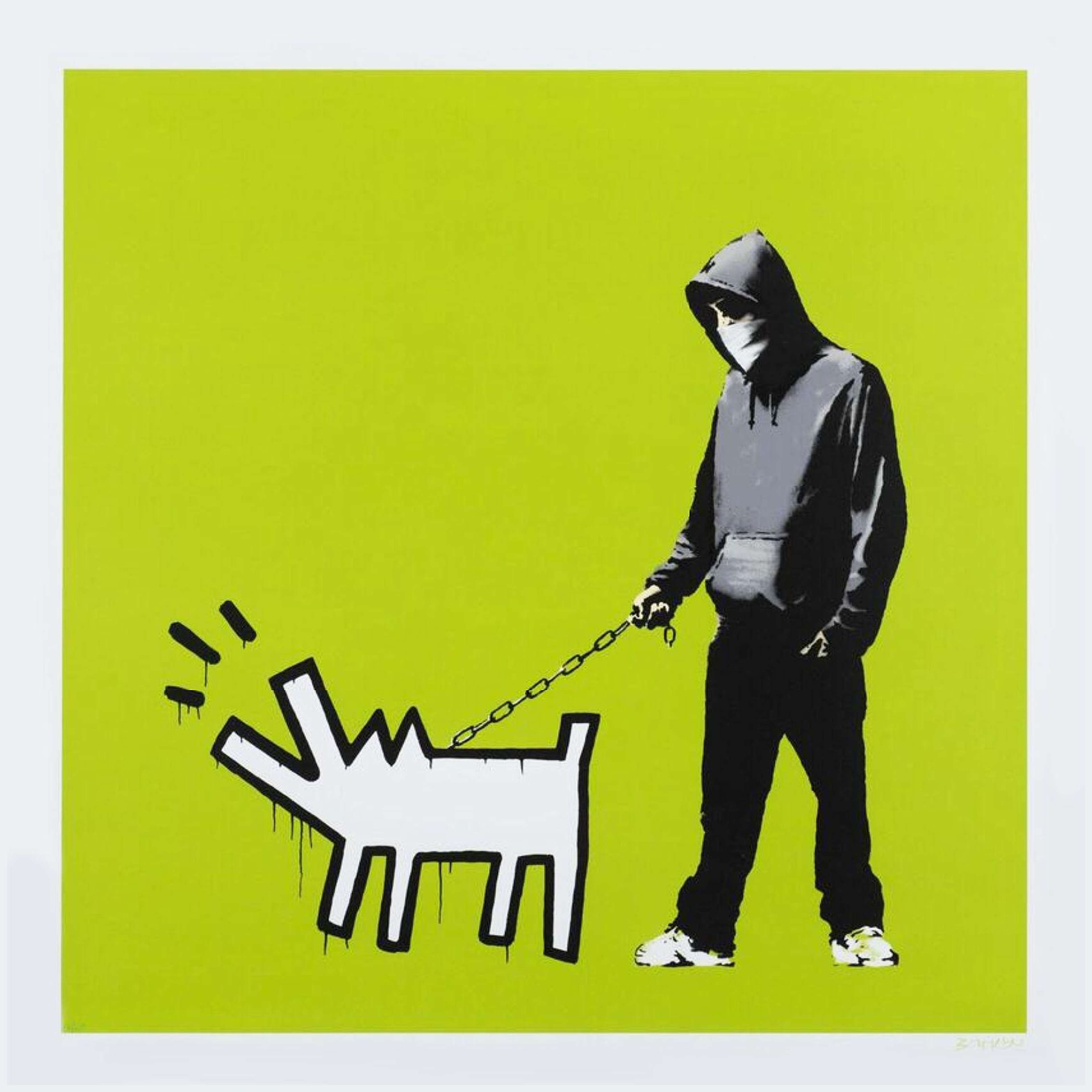 Dog © Keith Haring 1985
Dog © Keith Haring 1985
Interested in buying or selling
Keith Haring?

Keith Haring
249 works
When we think of the name Keith Haring, the Dog is perhaps the first image that comes to mind. From his early artistic endeavours in his Subways Drawings, Keith Haring's Dog became a clearcut symbol for the abuse of power and authority.
Haring's Dog symbolises the abuser of authority and power.
 Barking Dog (white) © Keith Haring 1990
Barking Dog (white) © Keith Haring 1990Haring's Barking Dog, with its mouth gaping open, represents the artist's suspicion of socio-political authority. Delineated with a continuous angular line, Haring's Dog is loaded with a sense of urgency and encourages viewers to be cautious of the establishment. Quite unlike the dog, Haring promotes disobedience to corrupt systems of power.
The standing dog is reminiscent of Ancient Egyptian hieroglyphics.
 Dog © Keith Haring 1985
Dog © Keith Haring 1985Throughout his artistic career, Haring attempted to create so-called 'modern hieroglyphics' that could be easily read by a wide-reaching audience. Haring's Dog was perhaps inspired by the Ancient Egyptian Anubis, the god of death, regeneration, and the afterlife, who also took the form of a dog. His 1985 Dog depicts a standing canine, filled with a hellish composition of death, sex, and violence, subverting the Ancient Egyptian hieroglyph to mirror the turmoil of the 1980s and the HIV/AIDS epidemic.
The Barking Dog is one of Haring's most iconic motifs.
 Barking Dog © Keith Haring 1990
Barking Dog © Keith Haring 1990Alongside Radiant Baby and Three Eyed Monster, Haring's Barking Dog is one of the artist's most repeated and recognisable motifs. Haring first conceptualised his Barking Dog in his early Subway Drawings, and from here it developed into a quintessentially Haring image.
Haring's Dog speaks to his fears surrounding the HIV/AIDS epidemic of the 1980s.
 Untitled (Dogs With Ufos) © Keith Haring 1982
Untitled (Dogs With Ufos) © Keith Haring 1982Throughout the 1980s, Haring used his unambiguous iconography to promote visibility around HIV/AIDS. In his Untitled (Dogs With Ufos), for example, Haring depicted three spotted dogs, potentially alluding to their infection with the disease. The central dog is being zapped by a UFO, a typical Haring symbol for empowering energy, and therefore conveys Haring's optimism for a definitive end to AIDS.
Haring's Barking Dog made clear Haring's disdain for the Reagan administration.
 Pop Shop IV, Plate IV © Keith Haring 1989
Pop Shop IV, Plate IV © Keith Haring 1989Haring's artwork not only promoted HIV/AIDS visibility, but also scrutinised the socio-political authorities that were so reluctant to address it. Haring's Barking Dog therefore became a staunch critique of Ronald Reagan's administration and his devaluing of queer lives during the epidemic.
Haring subverted naive cartoons to encourage his viewers to think critically.
 Barking Dogs © Keith Haring 1982
Barking Dogs © Keith Haring 1982Through his archetypal linear and naive style, Haring always urged his viewers to take a closer look beyond the seemingly innocent subject of his work. The dog, typically regarded as a loyal pet and 'man's best friend' becomes, in some of Haring's compositions, an enemy to humanity. The Barking Dog was created by Haring as a stirring symbol, encouraging viewers to question those who bark or shout the loudest.
Haring's Dog became a symbol of socio-political activism, championed by his creative successors.
 Choose Your Weapon (green) © Banksy 2010
Choose Your Weapon (green) © Banksy 2010Haring's Dog was appropriated by anonymous street artist Banksy in 2010. In his Choose Your Weapon series,
Haring's Dog has also been used as a symbol of creative freedom in 1980s America.
 DJ © Keith Haring 1983 © Keith Haring Foundation
DJ © Keith Haring 1983 © Keith Haring FoundationEven though Haring's Dog frequently appears as a symbol of oppressive authorities and abuses of power, he also used the motif to champion creativity in 1980s America. His DJ Dog is a joyous character, spinning his disks and barking to the music. In this instance, Haring's Dog is a torchbearer for thriving Hip Hop music and the eclectic night life of New York in the 1980s.
Haring used his Dog to convey the othering of those suffering from HIV/AIDS.
 The Blueprint Drawings 9 © Keith Haring 1990
The Blueprint Drawings 9 © Keith Haring 1990Haring's Dog featured prominently in his late series The Blueprint Drawings. In these works, the dog was presented as an anamorphic creature, representing the treatment of those suffering from HIV/AIDS as un-human. This was a sentiment perpetuated by governments throughout the 1980s, and Haring therefore used his Dog to challenge the stigma surrounding the disease.
Haring's Dog is an important component of his universal iconography.
 Dancing Dogs © Keith Haring 1981
Dancing Dogs © Keith Haring 1981Throughout his artistic career, Haring committed himself to creating a simple iconography that could be understood by all, regardless of language, class, sexual, and gender distinctions. Seeing as his Dog was one of the earliest motifs he developed and repeated, the character is testament to Haring's success in crafting this universally understandable imagery.
